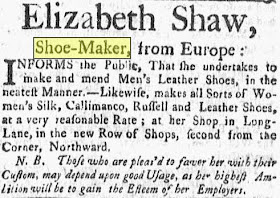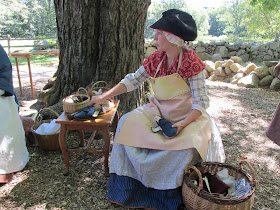Our day began bright and early with a trip to Hartwell Tavern at the Minute Man National Park to participate in the Hive's Challenge Event. I really wanted to go last year but was not able to. Check out the Hive's blog for posts on last year's Challenge.
 |
| Chatting with a couple lovely ladies at Hartwell Tavern. Photo by Friends of the Minute Man National Park Facebook page |
This is the description for this year's event.
"Across Two Summers Part II - The Countryside at War
"In the summer of 1775, the people of Massachusetts faced the challenge of supporting an army at war while at the same time trying to provide for their own homes and families. Visit Hartwell Tavern to learn about life during the Siege of Boston. Talk to displaced refugees traveling away from Boston and surrounding communities, as well as Provincial soldiers heading towards the front lines. Enlist in the Massachusetts Army, learn the proper military exercise of the day, help manufacture musket and artillery cartridges, and immerse yourself in another period of time, when nothing less than Liberty was at stake."
"In the summer of 1775, the people of Massachusetts faced the challenge of supporting an army at war while at the same time trying to provide for their own homes and families. Visit Hartwell Tavern to learn about life during the Siege of Boston. Talk to displaced refugees traveling away from Boston and surrounding communities, as well as Provincial soldiers heading towards the front lines. Enlist in the Massachusetts Army, learn the proper military exercise of the day, help manufacture musket and artillery cartridges, and immerse yourself in another period of time, when nothing less than Liberty was at stake."
Participants in the Challenge are asked to provide documentation for all their clothing which is then placed in a binder for the public to look through. I decided to go as a shoemaker. I wore my blue and white cross-barred gown and brought along my tools and unfinished shoes. Here is my documentation. I will have a separate post for Cori's attire.
Shift – Based on shifts in Costume Close Up by Linda Baumgarten and Fitting and Proper by Sharon Burston. Machine sewn but finished by hand.
Stays – First started in a Hive workshop. Pattern from a pair of 1770s fashionable stays in a private collection. Linen lining and blue worsted outer fabric, leather binding. All hand sewn.
Under petticoat – White linen under petticoat with printed cotton border. Based on a petticoat as seen in Fitting and Proper by Sharon Burston. All hand sewn.
Blue linen striped petticoat
– Blue linen and white striped petticoat made of two panels of fabric pleated to narrow waist
band. Ties front and back with linen ties, open at sided to allow access to
pockets. All hand sewn. The fabric came from Burnley and Trowbridge. I'm kicking myself for not buying more of it at the time. The fabric was a dream to work with!
Gown – The pattern for this gown was created in Hive workshop, based on original 18th gown in a private collection. It's made from a blue and white cross-barred linen with matching stomacher - Based on the print Native Meltons by British printmaker Richard Houston (c.1721-1775) after the painting by French artist Philippe Mercier (1689-1760). All hand sewn. I first posted about the gown here.
Gown – The pattern for this gown was created in Hive workshop, based on original 18th gown in a private collection. It's made from a blue and white cross-barred linen with matching stomacher - Based on the print Native Meltons by British printmaker Richard Houston (c.1721-1775) after the painting by French artist Philippe Mercier (1689-1760). All hand sewn. I first posted about the gown here.

 |
| This picture was taken about 2 years ago but it's a nice close of the gown, bonnet, and neckerchief together. |
Neckerchief –
"Stolen … Red Ground and
spotted with White" - Boston Gazette, February 19, 1770. Also based on
a red and white cotton neckerchief as seen in A City Shower, 1764- Museum of
London.For more information on handkerchiefs see my post Spotting Handkerchief in Art.
Aprons – Linen
check apron, all hand sewn. Print The
Jealous Maids in the Lewis Walpole
Library, linen check apron in the collection of Colonial
Williamsburg. “Said servant took with her … checked apron.” Pennsylvania Gazette 9-20-1775. There are also several examples of check fabric in the "Threads of Feeling" exhibit. Leather workman's apron. As seen in period prints of shoemakers and other tradesmen. The Contented Cobbler Publish'd July 14th 1772 by W. Humphrey Opposite Cecil Court St. Martin's. British Mezzotint Satires in North American Collections.
White linen cap – Linen cap, common 18th century style with single ruffle, hand sewn with red silk
ribbon. Similar to the cap worn in A City Shower, 1764-
Museum of
London.
Bonnet – Black silk bonnet with a red silk lining made by Hallie Larkin.
Common style of the 1770s. Black and red combination inspired by a mid 18th
century runaway servant ad. Similar to the bonnet in a 1772 print called Ladies Maid Purchasing a Leek. Black was the most common color of bonnets in the 18th century. You can read my post on bonnet colors here.
Stockings – Blue cotton stocking. “had on … yarn stockings of a blue color.” Connecticut Gazette, October 13, 1775
Shoes – Leather shoes with “silver” buckets of a style common to the mid 18th
century. Fugawee Shoes.
So, did women actually work as shoemakers in the 18th century? Yes they did! Although it was a far more common trade for men, there were some women such as Elizabeth Shaw making shoes in the Boston area. I first mentioned Elizabeth Shaw in my post here.
So, did women actually work as shoemakers in the 18th century? Yes they did! Although it was a far more common trade for men, there were some women such as Elizabeth Shaw making shoes in the Boston area. I first mentioned Elizabeth Shaw in my post here.
 |
| The Boston Post Boy & Advertiser, July 20, 1767 |
"Womens best Lynn
made Callimanco Shoes at 36s" Boston
Evening Post, April 26, 1765.
“Took with her a bundle of clothes. … a pair of blue worsted shoes with white heels. … She had in her
shoes a pair of large silver buckles.” Pennsylvania Packet, December 14, 1782
“Took with her … a pair of leather or purple velvet shoes
with square carved yellow shoes buckles.” Pennsylvania Packet, May 22, 1775
“Two pair black
cloth shoes.” Pennsylvania Packet, August 23, 1773
“Benjamin and
Holton Johnston, Shoemakers from Boston,
in Front Street,
two doors above Market Street.
Take this method to inform the ladies, that they make all sorts of silk and
worsted shoes, in the neatest and best manner. They likewise have the best Boston shoes to sell at
the very lowest rates. All those that will please to favor them with their
custom, may depend on being faithfully served.” Pennsylvania Gazette, May 30, 1765.
Put all above information together and here is what you get! I don't have a wooden tool box so I used a couple baskets to transport my shoes and tools. I was really glad I brought the little table you see, it made a great little work bench.
 |
| Not really sure what I'm doing in this picture. |
 |
| Yum, peaches for lunch! |
 |
| Photo by Friends of the Minute Man National Park Facebook page |
 |
| The *almost* finished shoe! |




You looked fantastic! This sounds like a really fun event. I'm so glad you were able to integrate the shoe-making and get a chance to show off those gorgeous shoes! :-)
ReplyDeleteIf I went to an event where there was a shoemaker, I think I'd just stand in front of them the whole time, staring quietly. So I hope I get the chance to see you in action sometime!
ReplyDeleteHaha, ok that's a little creepy but still funny. :) I hope we get to meet some day too!
ReplyDelete-Emily
I never get tired of seeing this dress, the fabric pattern is just lovely! Do you remember where you got it? I've looked in vain for a while now for something like it, alas.
ReplyDeleteHi Annabelle,
ReplyDeleteI bought the fabric several years ago from a lady who was downsizing her fabric stash. Sadly, I have no idea where she found it.
-Emily